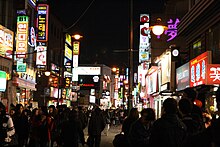Daehangno
You can help expand this article with text translated from the corresponding article in Korean. (February 2024) Click [show] for important translation instructions.
|
| Daehang-no | |
 Daehang-no at night | |
| Korean name | |
|---|---|
| Hangul | 대학로 |
| Hanja | 大學路 |
| Revised Romanization | Daehangno |
| McCune–Reischauer | Taehangno |
| Formerly known as | |
| Hangul | 숭교방 |
| Hanja | 崇敎坊 |
| Revised Romanization | Sunggyobang |
| McCune–Reischauer | Sunggyobang |
Daehang-no (Korean: 대학로; lit. college street) is a area in Jongno District within Downtown Seoul.
Formerly known as Sunggyo-bang (숭교방; 崇敎坊; lit. high respect for teaching), it received its current name after the 1.1 km six lane road from Hyehwa-dong rotary to Ihwa-dong crossroad was designated as a "street of culture" on May 5, 1985.[citation needed]
Daehang-no is the street from the crossroad of 79–1, Jongno 5-ga, Jongno District, to Hyehwa-dong rotary, 132, Hyehwa-dong.[citation needed]
History
[edit]King Taejo relocated Sungkyunkwan to the current location on Daehang-no, after the founding of the Joseon dynasty. This gave Daehang-no its former name, "Sunggyo-bang", meaning "high respect for teaching".[citation needed]
During the Japanese occupation, Keijō Imperial University was founded in this area. The university was later merged with other colleges to form the prestigious Seoul National University.[citation needed]
In 1956, Hakrim Dabang, now considered among the oldest active cafes in South Korea and the oldest in Seoul, opened on Daehangno.[1][2]
In March 1975, main campus of the Seoul National University was moved to Gwanak District by pressure from national government.[3] What came to the place where SNU left, was densely concentrated theatre district around Marronnier Park,[4] as the street was hub of Seoul's university culture in 1970s.[5]
See also
[edit]Notes and references
[edit]- ^ 윤, 대헌 (2017-12-05). [서울 그집 '오래가게'] 학림다방…한국 다방문화의 산실. Kyunghyang Shinmun (in Korean). Retrieved 2024-08-02.
- ^ "Hakrim Dabang". visitseoul.net. 2023-07-24. Retrieved 2024-08-01.
- ^ Han, Eun-hwa (13 March 2018). "Daehangno icon becomes a hub of innovation". Korea Joongang Daily. Seoul. Retrieved 2024-06-25.
- ^ Moon, Gwang-lip (20 July 2009). "A street where dreams come to life". Korea Joongang Daily. Seoul. Retrieved 2024-06-25.
- ^ Garcia, Cathy Rose A. (13 March 2018). "Arko Art Center Celebrates 30 Years in Daehangno". The Korea Times. Seoul. Retrieved 2024-06-25.

